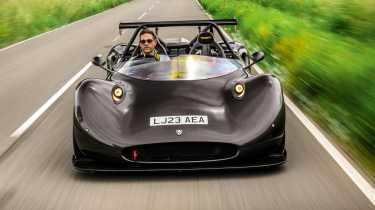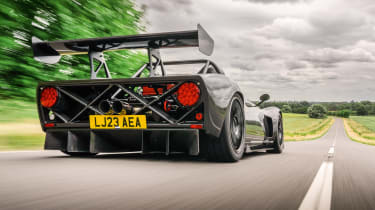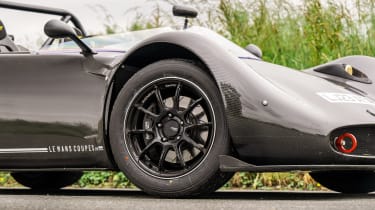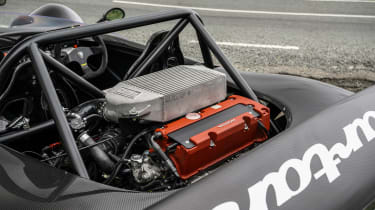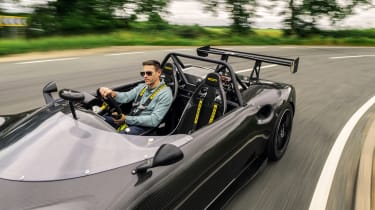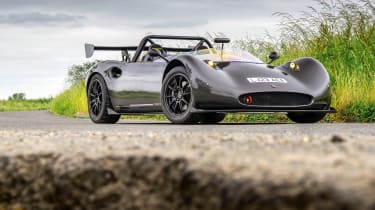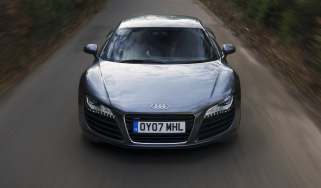Spartan (supercharged) 2023 review – hypercar pace for £162,000
With Can-Am looks, a 460bhp supercharged Honda engine, just 700kg to propel and no driver aids whatsoever, the Spartan is the thrill of driving in its rawest form
These are precious moments and they’re growing rarer by the hour, day, week, month and year. I’m handed a key – an actual key that must be inserted and twisted – to a car made by the Spartan Motor Company in Australia and imported, further developed and made road-legal by an outfit named Le Mans Coupes here in the UK. We know these guys well as they’re also the people to go to for the fabulous Superformance range of GT40, Shelby Daytona Cobra and Corvette Grand Sport. Wonderful monsters all.
Anyway, the Spartan. That rarest of things. A new car that’s properly light, that takes great pride in its manual gearbox and, refreshingly, doesn’t try to be all things to all people. Forget bandwidth. The Spartan weighs 700kg and has 460bhp. It’s hair-on-fire lunacy on road or track and all the better for it. The link for Le Mans Coupes, a company built upon selling wonderfully realised recreations of ’60s race cars, might not be obvious at first, but the Spartan’s Can‑Am-inspired styling is key, as company founder Oliver Hulme explains: ‘My father Nigel, he raced a Lola T70 for many years. So we just loved the idea of this, really. It’s a fantastic addition to what we do.’
> Ariel Hipercar prototype 2023 review
It’s a pretty compelling link, isn’t it? But you don’t need a history of wrestling T70s around Spa-Francorchamps to get the appeal of the Spartan: styling inspired by perhaps the coolest race series ever devised; lightweight tubular steel chassis with carbonfibre bodywork; double wishbones at each corner acting on TracTive semi-active dampers; mid-mounted Honda K24 2.4-litre in-line four with a Rotrex supercharger; six-speed manual ’box; AP Racing brakes; production limited to 300. I’m pretty much sold on this thing even before seeing it in the raw, unpainted carbonfibre.
The only difficult thing to swallow is the price. A car in this top spec is £162,000. The entry-level glassfibre-bodied Spartan with a naturally aspirated K24 engine is still £126k, and you have to add import costs to both, so a few grand more. Even setting aside the humble but scintillating Caterham Seven in its extreme forms or the more technically intriguing Ariel Atom, the aggressive pricing is an eye-opener. Dallara – a company that designs and develops F1 cars, supplies the entire IndyCar field, and builds chassis for Bugatti and the structure for the Cadillac LMDh that recently took a podium at Le Mans – will sell you its Stradale, complete with a carbonfibre tub and chassis tuning by supercar test driver royalty Loris Bicocchi, for a similar asking price. The Spartan story is rather different…
It was designed and developed in Australia by twins Peter and Nick Papanicolaou. The Paps grew up in Sydney, where their dad had an engineering workshop. Driving, building, designing and engineering is clearly their passion and the Spartan has been a long time in the making. Nick is an electronics engineer first and foremost, Peter a graphic designer. However, both grew up using lathes and milling machines and steeped in hands-on engineering. It seems a project like the Spartan was just a matter of time.
Way back in 2007 they started working on a concept that would grow into the Spartan: a small, lightweight barchetta powered by a Ducati V-twin engine lifted straight out of a brand-new 1198S. ‘The bike had only done 11km when we stripped it apart,’ remembers Peter with no hint of regret but a clear understanding of how mad the process sounds. Four years later the car was ready and unveiled at the Sydney Motorcycle Show. ‘We had great fun developing that thing on a friend’s private road… which was more like a little Nürburgring. But we knew the car needed more torque and greater durability. So we re-engineered it to accept a 1.5-litre Honda Jazz engine fitted with a Sprintex supercharger.’ The next chapter was a K24 and, as the promise of the project became clear, more experts were recruited for its fine-tuning: the chassis by Andre Nader, who has extensive experience in sportscar racing; aero by Sammy Diasinos, formerly of Toyota and Williams F1; and the final set-up work by ex-F3 driver Barton Mawer. It’s been a long hard road to get to here, then. Oh god, I hope their baby is good.
It looks the part, I have to say. There isn’t the scale or drama of a real-deal Can‑Am car but, well, nothing really has the presence of a real-deal Can‑Am car. Even so, it’s a lovely, clean, evocative shape and although the Spartan is a compact car there’s nothing toy-like about it. I also love the sense of purpose. There’s beauty in the lines and in the perfectly matched weave of the carbon, but the Spartan sweats a tough, businesslike aura. Later I’ll come to wonder if there’s enough engineering jewellery for this price point, but right now I just love the tension and the motorsport componentry. The AP Racing brakes poking through simple ten-spoke Advan RZ wheels and the Yokohama A052 semi-slicks with a proper sidewall just reek of racetrack. There are no driver aids. At all. Not even ABS.
As you may have noticed, there are no doors either. Simply step into the Spartan and then slide your legs down towards the Tilton bias pedal box. More good stuff. This is still a development car, so there’s a button-free and surprisingly large Sabelt steering wheel with an AiM dash screen mounted behind. The final cars will feature the AiM SW4 steering wheel with integrated screen, which will add a dash of Formula-style technology to the classical sensibility. Mounted centrally there’s a control panel with ignition and start buttons and other basic functions, and to its right a small readout for the TracTive semi-active dampers. More on which later.
Right now I’m just happy to have plenty of space to work, pleased by the simplicity and sound ergonomics of the driving position and intrigued by the exposed shifter of the six-speed gearbox. The Honda engine is fully exposed too, cam cover and intercooler poking through the bodywork, evocative of the great intake trumpets on a McLaren M8’s mighty Chevrolet V8. (Okay, maybe I’m getting a little carried away. Anyway, I’m excited.) Today will be restricted to road driving and the car is running its correspondingly more forgiving ride height. Even so, the TracTive dampers offer plenty of adjustability and even eliminate mechanical anti-roll bars. M1 and M5 presets are nominal road and track settings but owners have plenty of scope to experiment on the fly or add new favourites to the remaining memory positions.
Twist the key, thumb Ignition and then Start and the supercharged engine buzzes to life and its fast idle tingles through the whole car. These Honda units rev beautifully and are strong and reliable, but the noise is plain and shrill. There’s no throaty twin-cam roar, just a flat, busy mechanical thrash. The mini Can‑Am vibe doesn’t quite materialise. Hopefully the supercharger will add some aural excitement once the revs pick up. At least the view out adds a layer of the exotic. The curves that flow over the wheels are gorgeous and have the added benefit of locking-in the road ahead like a target. The periscope rear-view mirror full of wing is beguiling, too. Of course, the aero package isn’t just for decoration. The Spartan produces 299kg of downforce at 200kph (124mph), 467kg at 250kph (155mph). Remember, the kerb weight is just 700kg.
First impressions are of a car that’s intuitive and driver-friendly – helped by the abundant torque and the six-speed gearbox – but extremely intense. Even at low speeds the Spartan pulsates with the energy buzzing out of the Honda engine. The seat and pedals are alive to its every action and hence throttle inputs not only create vivid, inertia-free acceleration but seem to energise the whole car as it fizzes and vibrates like a go-kart. The aeroscreen might help isolate the driver from the slipstream a little, but your head still bobs in the rush of wind and there’s a blaring, buffeting cacophony swirling around you all the time. A full-face helmet is a necessity for anything above about 20mph if you want to see where you’re going.
Yet whilst the physicality of the Spartan is at times overwhelming, the dynamics are mostly calm and clearly trustworthy. The steering isn’t darty or edgy at all and there’s filtered but fine feedback. Start to roll the car into corners with more speed and it moves with that easy, effortless feel that only a light machine with sticky tyres can conjure. The grip seems almost boundless and there’s so much natural agility. The Spartan may have been developed with cursory attention paid to the road, but driven quickly but smoothly and without awakening the really angry part of the rev range, it has a lovely sense of cohesion. I love the brakes, too. There’s so much feel and progression that locking them isn’t a worry at all, even in really bumpy braking zones.
The noise never really improves – perhaps because developing subtler delights like this inevitably shuffles down the list of priorities with the binary needs of a track machine – and it does feel like this is a missed opportunity. We know from shrieking previous-generation supercharged Ariel Atoms that real drama and a sense of occasion can be extracted from these engines. The Spartan barely sounds supercharged at all and the plain, harsh noise is pretty uninspiring. However, you don’t have time to realise this until a few hours later, such is the scale of the performance. It is wildly, overwhelmingly and, honestly, quite terrifyingly quick. Wringing the Spartan out to the limiter takes real commitment. There’s so much noise, the weight of your helmet is being buffeted around by the onslaught of wind and longitudinal g, the car is zinging like a tuning fork and the speed readout is a blur. Add to that the suspension starting to struggle with the lumps and bumps of a challenging road surface and the experience starts to feel uncomfortably thrilling. Like it shouldn’t really be allowed.
The gearbox adds to the frenzy. It’s light, precise and will take shifts as fast as your arm can move. It’s wonderfully exciting firing through the upshifts. Perhaps there isn’t the polish of a Dallara Stradale or the suppleness of, say, a well set up Atom, but the Spartan is intense and deeply, unsettlingly thrilling.
Incredibly, traction through the Quaife ATB differential is superb and on a cool, dry day there’s no worry about wheelspin at all. Provoke the Spartan and it tends towards a little understeer and then very mild oversteer on corner exit. For me the car needs a bit more rake and it turned out that the ride height was set incorrectly for our test. I’d like to try it again with the front height reduced as I think it would breed more confidence and perhaps make the car feel a little more playful, too. Spartan tried a more traditional differential but felt it made the car too edgy under braking. On track that might be true, but I wonder if a plated diff would actually help the car to feel slightly more natural on the road.
The TracTive dampers are fascinating. They use a multi-axis g sensor to feed information to an internal DDA (Dynamic Damping Adjustment) valve. Capable of responding in 6-8 milliseconds, the DDA is said to react to surface changes and loads before you even feel them. So, for example, as you hit apex or exit kerbs, the dampers can absorb the blow and then tense up again to maintain body control in incredibly short order. In theory, the balance of the car can be tweaked with fine adjustment of roll stiffness, pitch and dive and suspension behaviour at different phases of a corner.
The preset road and track settings certainly make a tangible difference to the car’s balance and ride quality. I prefer the directness and more ‘on the nose’ feel of the track default, but clearly we’re not in the right environment to judge the ultimate set-up. In fact, it feels unfair judging the Spartan on the road alone as the Paps are pretty clear that this thing is all about track fun and performance. ‘Getting the cars road-registered here in Australia or places like the US is really difficult,’ says Peter. ‘In some ways, it’s just a bonus that it can be driven to the track in the UK.’
This single-minded focus is fantastic in some senses. The Spartan’s performance, agility, massive grip and superb traction will clearly be breathtaking on a circuit. It’s also obvious that the mechanical package and the feel of the car has been just as expertly honed as the aerodynamic performance. However, perhaps it hasn’t allowed the Paps to develop some of the seemingly small details that can turn a performance car into something inspirational. The finish of the carbon body is fantastic but the inside is more rudimentary and needs refining. The noise could and should be more musical – or more unhinged like those previous Atoms – and I think a bit more beauty in the details would elevate the car considerably. It’s amazing how a gorgeous exhaust manifold can lift your mood: the BAC Mono is a great example of layering art on top of engineering function. If the Spartan can take that next step then it will begin to justify the asking price.
Spartan (supercharged) specs
| Engine | In-line 4-cyl, 2354cc, supercharged |
| Power | 460bhp @ 7700rpm |
| Torque | 341lb ft @ 6550rpm |
| Weight | 700kg |
| Power-to-weight | 668bhp/ton |
| 0-62mph | 2.5sec |
| Top speed | 155mph-plus |
| Basic price | £162,000 |
This story was first featured in evo issue 313.

